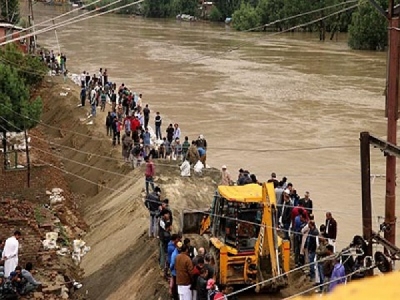
Posted on August 1, 2018
As heavy rains often trigger flood scare in Kashmir, particularly in Srinagar, the Irrigation and Flood Control department has initiated a multi-pronged strategy to increase outflow capacity of Jhelum by dredging Wular lake and enhance storage capacity of other water bodies.
The I&FC department has started focusing on critical areas to increase carrying capacity of Jhelum to 60,000 cusecs.
Official say only one-fifth of the original with of Jhelum remains, owing to rampant encroachment.
Experts say that is the major reason why lesser intensity rainfall often creates flood-like situation in Kashmir, a phenomenon which has repeated itself at least five times since 2014.
“We are working on a multi-pronged strategy on flood management. First part is increasing the outflow of river Jhelum by dredging from Wular Lake. Dredging work is going at outflow channels, two dredgers are operational currently,” said Farooq Shah, secretary Irrigation and Flood Control.
After the devastating floods of 2014, a study titled ‘A satellite-based rapid assessment on floods in Jammu & Kashmir’, conducted jointly by department of environment and remote sensing (DERS) and ISRO recommended immediate de-siltation of lakes, revival of flood basin of Khushalsar, Gilsar, Anchor, Hokarsar, Shallabugh, Haigam, preparing a flood zonation map, construction of an alternate flood channel and regular dredging of the rivers to handle future flood threats.
“Other part is re-sectioning of river Jhelum by restoring capacity of flood channels. Re-sectioning of flood channels at Shariefabad and Rawalpora are going on at full swing,” Shah said.
“It would help in diverting water during times of high discharge in the river Jhelum.”
Shah says about 140 spots on the tributaries have been temporarily restored and strengthened and 25 spots Jhelum are under progress. He said water bodies were being restored to their full capacity.
“Flood channels will help in increasing carrying capacity of Jhelum to 60,000 cusecs. It will help in flood management by charging these water bodies at the time of rising water level in the river.”
Rainwater has deposited tones of silt in Jhelum, reducing its capacity to less than 25,000 cusecs of water. The water holding capacity of the flood spill channel (FSC) – the only outlet available to mitigate flood discharge bypassing Srinagar – running parallel to the river has fallen to less than 5,000 cusecs.
New Delhi sanctioned Rs 399 crore for dredging of Jhelum and FSC to increase their capacity to 60,000 cusecs.
Under the ‘comprehensive Flood management Plan on River Jhelum-Phase-I’, a Rs 46-crore contract for dredging was allotted to Kolkata-based firm Reach Dredging Limited in 2015.
However, the target was never met. The firm finally left the job in March this year, falling short of the target by three lakh cubic meters of dredging.
Source: Greater Kashmir





